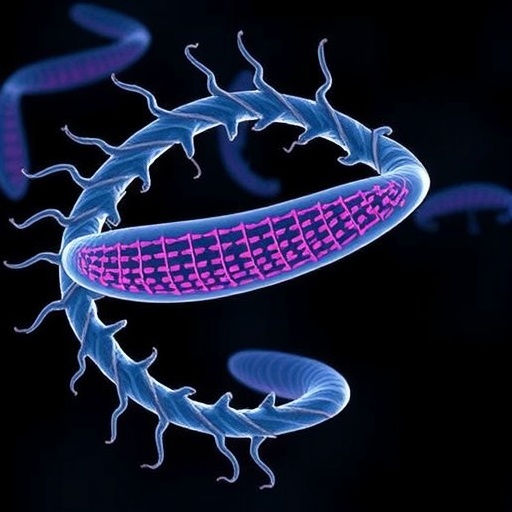In a groundbreaking study published in BMC Genomics, researchers delve into the intricate molecular landscape of the nematode, Anisakis simplex, specifically focusing on its L3 and L4 developmental stages. The multi-faceted analysis conducted by Polak, I. and colleagues uncovers profound insights into how glucose influences gene expression and protein activity during crucial transitions in the lifecycle of this parasitic organism. The significance of this research extends beyond basic science, potentially informing new strategies for managing parasitic infections in both fish and humans.
Using a cutting-edge combination of transcriptomic and proteomic methodologies, the team meticulously analyzed the genetic and protein variations that occur between the L3 and L4 stages of Anisakis simplex. This nematode is widely recognized for causing anisakiasis, a disease transmitted to humans through the consumption of poorly cooked or raw fish. Understanding the biological adaptations of this parasite during its lifecycle stages can aid in the development of more effective public health strategies.
The application of high-throughput sequencing technologies allowed the researchers to capture a comprehensive snapshot of gene expression changes in Anisakis simplex across its developmental stages. By utilizing RNA-sequencing techniques, they successfully identified key transcripts that exhibit dynamic alterations as the parasite transitions from the L3 stage, where it is primarily found in aquatic hosts, to the L4 stage, which is prepared for further development within definitive hosts, including fish and mammals.
In addition to transcriptomic analysis, the proteomic component of this study further illuminates the functional aspect of gene expression. Through mass spectrometry, the researchers quantified protein levels corresponding to the identified transcripts, verifying the biological significance of these changes. This dual approach not only highlights which genes are activated in response to glucose but also how these changes manifest at the protein level, a critical factor in understanding cellular functions and pathways.
The insights into target genes influenced by glucose offer a fascinating glimpse into the metabolic adaptations of Anisakis simplex. Glucose is not just a primary energy source; it plays a pivotal role in regulating gene expression and protein synthesis. As the researchers explore the transcriptional dynamics and subsequent protein interactions, they uncover potential metabolic pathways that the parasite exploits during its lifecycle stages. This could be instrumental in developing interventions that disrupt these pathways, making it harder for the nematode to thrive.
Moreover, the study suggests a robust correlation between glucose availability and the physiological makeup of Anisakis simplex. By checking how the organism adjusts its metabolic processes in response to varying glucose levels, the researchers hypothesize that the nematode has evolved complex mechanisms to optimize its growth and development within the host environment. These mechanisms could advance our understanding of parasitic biology and the energetic demands that facilitate such transitions.
One of the standout findings of this research is the identification of specific gene clusters that display heightened expression during the L4 stage compared to the L3 stage, stimulated by glucose levels. This indicated that glucose not only serves as a metabolic substrate but also acts as a signaling molecule, influencing important developmental processes and preparation for future reproductive stages. These findings resonate within the broader context of parasitology, where understanding developmental biology can lead to innovative control measures against parasitic infections.
The study presents a significant leap in our understanding of Anisakis simplex, ultimately revealing its complex interactions with host environments and metabolic substrates. As the authors draw upon their research findings, they make a compelling case for the importance of studying parasitic organisms through a multi-omics lens. This integrative approach brings forth new dimensions of research that could shed light on other parasitic species, unraveling their secrets in a similar manner.
As we reflect on the public health implications of this research, it is essential to consider the potential applications of these findings. Considering how the global rise in fish consumption has been linked to increased cases of anisakiasis, understanding the molecular basis of this parasite could pave the way for better monitoring and control strategies in fisheries. Policymakers can benefit from this knowledge, designing regulations that may mitigate the risk of transmission to humans.
In conclusion, this study not only advances our knowledge of Anisakis simplex but also fosters a deeper appreciation for the intricacies of parasitic life cycles and host interactions. As science continues to unfold the mysteries of biological organisms, including parasites, we are reminded of the interconnectedness of our ecosystems and the delicate balance that sustains life. The rich data set generated here sets the stage for future research that promises to further clarify the enigmatic world of parasitic threats as they adapt and evolve in response to various environmental factors.
By bridging transcriptomic and proteomic analyses, the researchers illuminate the pathways of glucose influence on development and gene expression in Anisakis simplex. This comprehensive study adds a vital layer to our understanding of this parasite and poses new questions that beckon further exploration in parasitic research, ultimately aiming for improved strategies in managing and controlling infections caused by these organisms.
With continued research into the metabolic and developmental characteristics of Anisakis simplex and other parasites, we inch closer to unraveling the complexities associated with parasitic diseases. Such discoveries have far-reaching implications, equipping researchers, healthcare professionals, and policymakers with the tools needed to combat these persistent challenges in human health and food safety.
Subject of Research: Coupled transcriptome and proteome analysis of Anisakis simplex developmental stages
Article Title: Coupled transcriptome and proteome analysis of L3 and L4 developmental stages of Anisakis simplex s. s.: insights into target genes under glucose influence
Article References:
Polak, I., Stryiński, R., Maździarz, M. et al. Coupled transcriptome and proteome analysis of L3 and L4 developmental stages of Anisakis simplex s. s.: insights into target genes under glucose influence.
BMC Genomics 26, 866 (2025). https://doi.org/10.1186/s12864-025-12068-w
Image Credits: AI Generated
DOI: 10.1186/s12864-025-12068-w
Keywords: Anisakis simplex, glucose influence, transcriptome analysis, proteome analysis, nematodes, parasitology, public health.




